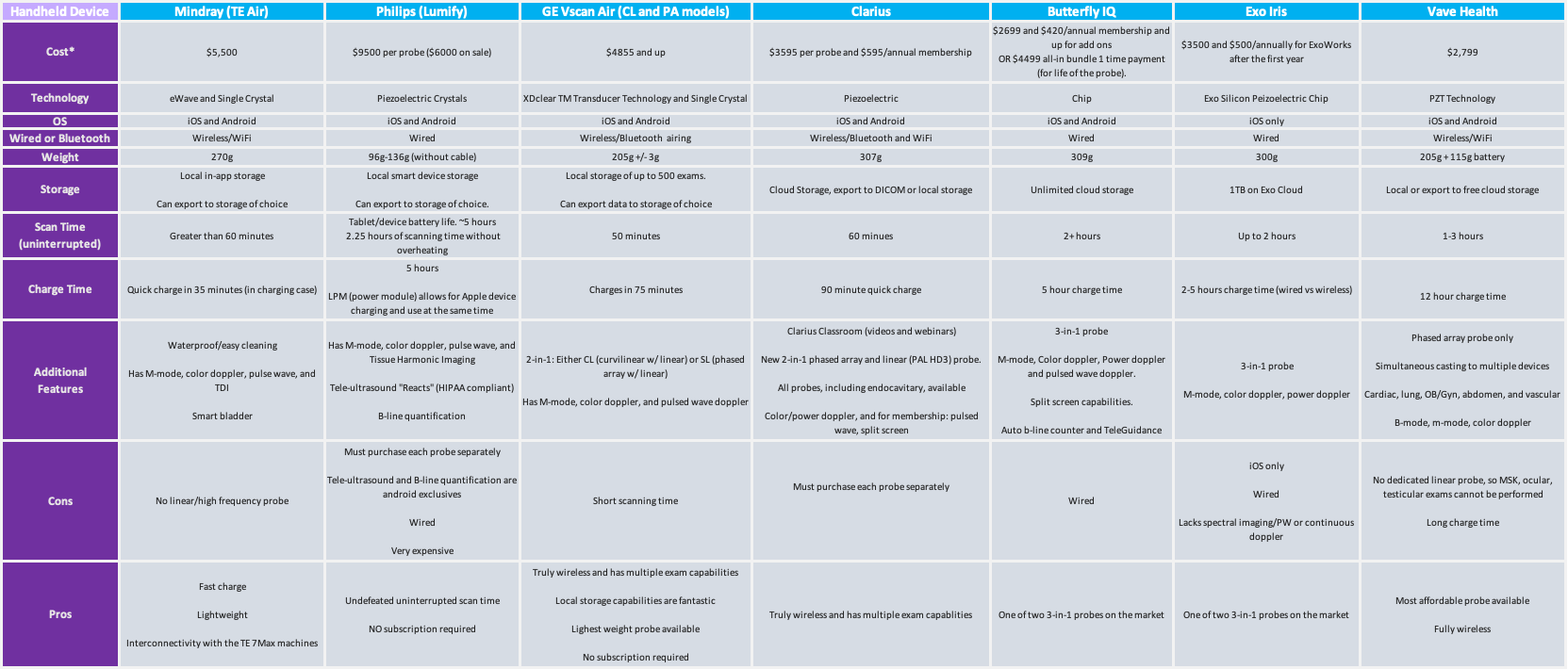
Handheld Ultrasound Market Round-up
Lynea Bull, MD
Emory University
Handheld ultrasounds are here to stay.
Not only have we seen great strides in utilization of point-of-care ultrasound (POCUS) in the emergency department, but we have also seen an expansion of uses of ultrasound outside the hospital. From pre-hospital assessment and care to expansion of imaging capabilities in global health, handheld ultrasounds are creating a world in which high quality emergency care can be accessible to all.
It’s been a few years since the last ACEP Newsletter Handheld Ultrasound round-up. Since then, market options have contracted and expanded. We’ve seen the loss of the Sonosite handheld and the emergence of a newcomer: the Exo Iris. There is a handheld ultrasound out there to meet the needs of every emergency physician, expert, and beginner.
The 3-in-1
When it comes to versatility, the 3-in-1 handheld options are making great technologic strides. The Butterfly iQ and Exo Iris are two handhelds on the market that offer phased array, curvilinear, and linear probe settings with a single transducer. Both utilize chip technology to produce high quality images.
-Butterfly iQ
Pros:
- 3-in-1 probe with many exam presets
- has high yield and advanced scanning modes (color doppler, power doppler, pulse wave, and m-mode)
- split screen capabilities
- cloud storage
- auto b-line counting and tele-ultrasound access via the subscription (useful for EM in austere settings, for novice sonographers, and others who might benefit from feedback from experts).
Cons:
- probe connects to tablet/phone via wire
- subscription fees
- Long charge time
Unique feature:
- Developer Dreamland: the “Butterfly Garden: AI Marketplace” provides access to their Software Development Kit where users can build custom AI Apps.
-Exo Iris
Pros:
- 3-in-1 probe with many exam presets
- 1TB of cloud storage
- has three high yield scanning modes (color doppler, power doppler, and m-mode)
Cons:
- iOS only (no android compatibility)
- probe connects to tablet/phone via wire
- lacks pulse wave and continuous doppler scanning modes
- subscription fees
The 2-in-1
While 3-in-1 probes sound ideal, some argue what can be done with the phased array can also be done with the curvilinear probe. For those that believe in the interchangeability of the low frequency probes, the 2-in-1 handhelds might be ideal. Additionally, novice sonographers (learners such as medical students and residents, and educators who want to make ultrasound more accessible to their learners) might find it ideal to have access to a probe with fewer settings, in exchange for a lower price point.
-GE VScan Air
Pros:
- Completely wireless
- very lightweight
- quick charge time
- has linear probe with either a curvilinear or phased array
- multiple scanning modes (m-mode, color doppler, and pulse wave doppler)
- no subscription required.
Cons:
- Short uninterrupted scan time
- lacks continuous doppler scanning mode
Unique feature:
- Lightweight Champion: This is the lightest handheld included in this Round-up
-Clarius PAL HD3
Pros:
- Completely wireless
- Piezoelectric technology for very good image quality
- Quick charge time
- Multiple scanning modes (color/power doppler and, with a subscription, pulsed wave and split screen)
Cons:
- If not purchasing the PAL HD3 2-in-1, you must buy each individual probe separately
- Subscription fees
- Short interrupted scan time
Unique feature:
- Ultrasound University: The “Clarius Classroom” provides access to webinars and videos to help you further your ultrasound education.
The 1-and-done
While it’s nice to have single probes with capability of switching between phased array and linear at the push of a button only without having to physically pick up a different probe, we must remind ourselves that our cart-based systems work just fine the way they are, so our handhelds can too. What these probes all have in common is utilizing piezoelectric technology to produce images that rival cart-based systems’ image quality. Most of these tend to be on the more expensive side, especially if there is a desire to own more than one probe for multiple exam types.
-Mindray TE Air
Pros:
- Completely wireless
- Piezoelectric technology for very good image quality
- Quick charge time
- Lightweight
- multiple scanning modes (m-mode, color doppler, pulse wave doppler, and TDI)
- No subscription required
Cons:
- Phased array probe only
- probe connects to tablet/phone via wire
Unique feature:
- Cart Buddy: you can pair this device with certain cart based Mindray systems
-Philips Lumify
Pros:
- Piezoelectric technology for very good image quality
- Long uninterrupted scan time
- multiple scanning modes (m-mode, color doppler, pulse wave doppler, and tissue harmonic imaging)
- No subscription required
Cons:
- Must buy each individual probe separately
- Expensive
- probe connects to tablet/phone via wire
Unique feature:
- Longevity: scanning time is based on the battery power of the screen/device, which allows this probe to last longer than all the others for scanning
-Vave Health
Pros:
- Most affordable 1-and-done probe
- Does have vascular preset
- Has 3 basic modes (b-mode, m-mode, color doppler)
Cons:
- Phased array probe only
- No linear probe: no musculoskeletal, ocular, or testicular presets
- Long charge time
Unique feature:
- Image Review Party—you can simulcast active exams to multiple screens.


